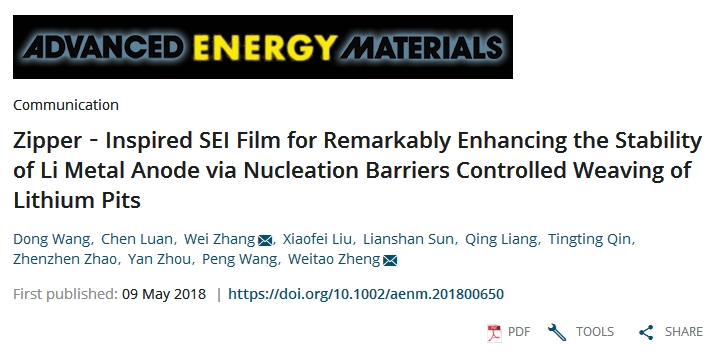Search Product
Structure Search
Search
Advantage Products
Location: Industrial Info
Zippered SEI film solves the problem of lithium dendrite
2018-08-10
来源:转载自第三方
10 August 2018
Recently, researchers at Jilin University changed the problem of lithium dendrite from inhibition to dredging. Starting from different nucleation regions on the surface of lithium metal, a simple surface patterning process was used to form a network of lithium on the surface of lithium metal. And then they explain the mechanism of this recyclable uniform and dendritic formation. Related research is published in the journal Advanced Energy Materials under the article entitled "Zipper-Inspired SEI Film for Remarkably Enhancing the Stability of Li Metal Anode via Nucleation Barriers Controlled Weaving of Lithium Pits".

A lithium metal battery refers to a battery using lithium metal as a negative electrode. The positive electrode material to which it is used may be oxygen, elemental sulfur, metal oxide or the like, which is likely to become a next-generation energy storage battery. The lithium metal anode has a capacity ten times that of the graphite anode (3860 mAh g-1) and the most negative potential, and thus has received great attention from researchers. However, in the process of repeated deposition and precipitation of lithium ions, the surface of the metal lithium anode easily grows lithium dendrites, which becomes a roadblock for the recycling of lithium metal batteries, which not only greatly reduces the utilization rate of the battery, but also may lead to the short-circuited, posing a safety hazard.
How to inhibit the growth of lithium dendrites? At present, methods for inhibiting the growth of metal lithium dendrites include using an electrolyte additive (film forming additive, deposition additive, ex situ solid electrolyte interface film additive, etc.), using a solid electrolyte, using a high salt concentration electrolyte, a nanometer electrolyte, or structured anode reduces the volume expansion problem during charging and discharging. In a conventional manner, obtaining a strong SEI film suppresses the formation of lithium dendrites.
However, "inhibiting" is not as good as "dredging". In this study, the researchers proposed a new strategy to effectively release stress by controlling the rupture zone of the SEI film to minimize the opening or rupture to form a uniform lithium pit. During lithium deposition, the zippered SEI film provides an ordered pattern on the surface of the Li anode by mechanical rolling. In the same electrolyte, stable and dendritic-like uniform growth of Li is achieved. The lithium metal anode has no obvious dendrite formation in 100 cycles, and the assembled lithium iron phosphate and lithium copper half-cells have significantly improved performance compared to unmodified lithium metal.
Although lithium metal batteries are currently receiving widespread attention in the industry, there are still many challenges to be applied to them in large scale. The study proposes new methods and ideas for inhibiting lithium dendrites, making the development of lithium metal batteries and large-scale commercialization a step forward.
References
[1] Dong Wang, Chen Luan, Wei Zhang, et al. Zipper‐Inspired SEI Film for Remarkably Enhancing the Stability of Li Metal Anode via Nucleation Barriers Controlled Weaving of Lithium Pits. Advanced Energy Materials, 2018, doi:10.1002/aenm.201800650.
Edited by Suzhou Yacoo Science Co., Ltd.
如果涉及转载授权,请联系我们。












